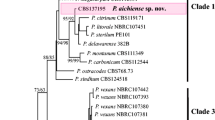Abstract
The new genus Cyanonectria is proposed for Nectria cyanostoma (≡ Cyanonectria cyanostoma comb. nov.). This genus is characterized by Nectria-like, red perithecia that have a bluish-purple papilla and a Fusarium anamorph. DNA sequences (large subunit and internal transcribed spacers of the nuclear rDNA) indicate that C. cyanostoma is not closely related to Nectria sensu stricto. In addition, the phylogenetic data also show that the closest relatives for Cyanonectria also have Fusarium anamorphs.


Similar content being viewed by others
References
Booth C (1971) The genus Fusarium. Commonwealth Mycological Institute, Kew, Surrey, UK
Castlebury LA, Rossman AY, Sung GH, Hyten AS, Spatafora JW (2004) Multigene phylogeny reveals new lineage for Stachybotrys chartarum, the indoor air fungus. Mycol Res 108:864–872. doi:10.1017/S0953756204000607
Felsenstein J (1989) PHYLIP - Phylogeny Inference Package (Version 3.2). Cladistics 5:164–166
Galtier N, Gouy M, Gautier C (1996) SEAVIEW and PHYLO_WIN:two graphic tools for sequence alignment and molecular phylogeny. Comput Appl Biosci 12:543–548
Gerlach W, Nirenberg HI (1982) The genus Fusarium — A pictorial atlas. Mitt Biol Bundeseanst Land- Forstw Berlin-Dahlem 209:1–406
Guindon S, Gascuel O (2003) PhyML - A simple, fast, and accurate algorithm to estimate large phylogenies by maximum likelihood. Syst Biol 52:696–704. doi:10.1080/10635150390235520
Huelsenbeck JP, Ronquist F, Nielsen ES, Bollback JP (2001) Bayesian inference of phylogeny and its impact on evolutionary biology. Science 294:2310–2314. doi:10.1126/science.1065889
Huelsenbeck JP, Larget B, Miller RE, Ronquist F (2002) Potential applications and pitfalls of Bayesian inference of phylogeny. Syst Biol 51:673–688. doi:10.1080/10635150290102366
Leslie JF, Summerell BA (2006) The Fusarium laboratory manual. Blackwell, Ames, IA
Mason-Gamer RJ, Kellogg EA (1996) Testing for phylogenetic conflict among molecular data sets in the tribe Triticeae (Gramineae). Syst Biol 45:524–545. doi:10.2307/2413529
Nirenberg HI (1976) Untersuchungen über die morphologische und biologische Differenzierung in der Fusarium-Sektion Liseola. Mitt Biol Bundesanst Land- Forstw Berlin-Dahlem 169:I–v + 1–117
Nirenberg HI, O’Donnell K (1998) New Fusarium species and combinations within the Gibberella fujikuroi species complex. Mycologia 90:434–458. doi:10.2307/3761403
O’Donnell K (2000) Molecular phylogeny of the Nectria haematococca-Fusarium solani species complex. Mycologia 92:919–938. doi:10.2307/3761588
O’Donnell K, Cigelnik E, Nirenberg HI (1998) Molecular systematics and phylogeography of the Gibberella fujikuroi species complex. Mycologia 90:465–493. doi:10.2307/3761407
Pfister DH (1985) A bibliographic account of exsiccatae containing fungi. Mycotaxon 23:1–139
Posada D (2008) jModelTest:Phylogenetic Model Averaging. http://darwin.uvigo.es/
Posada D, Buckley TR (2004) Model selection and model averaging in phylogenetics: advantages of the AIC and Bayesian approaches over likelihood ratio tests. Syst Biol 53:793–808. doi:10.1080/10635150490522304
Reeb V, Lutzoni F, Roux C (2004) Contribution of RPB2 to multilocus phylogenetic studies of the euascomycetes (Pezizomycotina, Fungi) with special emphasis on lichen-forming Acarosporaceae and evolution of polyspory. Mol Phylogenet Evol 32:1036–1060. doi:10.1016/j.ympev.2004.04.012
Rossman AY (1989) A synopsis of the Nectria cinnabarina-group. Mem NY Bot Gard 49:253–265
Rossman AY, Samuels GJ, Rogerson CT, Lowen R (1999) Genera of Bionectriaceae, Hypocreaceae, and Nectriaceae (Hypocreales, Ascomycetes). Stud Mycol 42:1–248
Rossman AY, McKemy JM, Pardo-Schultheiss RA, Schroers H-J (2001) Molecular studies of the Bionectriaceae using large subunit rDNA sequences. Mycologia 93:100–110. doi:10.2307/3761609
Saccardo PA (1902) Manipolo di micromiceti nuovi. Rendi Congr Bot Palermo 1902:46–60
Saccardo PA (1903) Un Nectria probablement hybride, Nectria cyanostoma (Manipolo de Micromiceti nuovi) (3). Rev Mycol Toulouse 40:41
Samuels GJ, Rogerson CT (1984) Nectria atrofusca and its anamorph, Fusarium staphyleae, a parasite of Staphylea trifolia in eastern North America. Brittonia 36:81–85. doi:10.2307/2806300
Samuels GJ, Nirenberg HI, Seifert KA (2001) Perithecial species of Fusarium. In: Summerell BA, Leslie JF, Backhouse D, Bryden WL (eds) Fusarium: Paul E. Nelson Memorial Symposium. APS Press, pp 1–14
Seifert KA (1985) A monograph of Stilbella and some allied hyphomycetes. Stud Mycol 27:1–235
Swofford DL (2002) PAUP 4.0b10. Sinauer, Sunderland, MA
Tan MK, Niessen LM (2003) Analysis of rDNA ITS sequences to determine genetic relationships among, and provide a basis for, simplified diagnosis of Fusarium species causing crown rot and head blight of cereals. Mycol Res 107:811–821. doi:10.1017/S0953756203008013
Thompson JD, Gibson TJ, Plewniak F, Jeanmougin F, Higgins DG (1997) The ClustalX windows interface: flexible strategies for multiple sequence alignment aided by quality analysis tools. Nucleic Acids Res 24:4876–4882. doi:10.1093/nar/25.24.4876
Vilgalys R, Hester M (1990) Rapid genetic identification and mapping of enzymatically amplified ribosomal DNA from several Cryptococcus species. J Bacteriol 172:4238–4246
von Höhnel F (1919) Rehm: Ascomycetes exs. Fasc. 57 and 57. Ann Mycol 16:209–224
White TJ, Bruns T, Lee S, Taylor JW (1990) Amplification and direct sequencing of fungal ribosomal RNA genes for phylogenetics. In: Innis MA, Gelfan DHd, Sninsky JJ, White TJ (eds) PCR Protocols: a guide to methods and applications. Academic Press, New York, pp 315–322
Zhang X-M, Zhuang W-Y (2006) Phylogeny of some genera in the Necctriaceae (Hypocreales, Ascomycetes) inferred from 28S nrDNA partial sequences. Mycosystema 25:15–22
Acknowledgements
This study was supported in part by the United States National Science Foundation (NSF) PEET DEB grant 9712308, ‘Monographic Studies of Hypocrealean Fungi: Hypocrea and Hypomyces’ to the Pennsylvania State University, Department of Plant Pathology and by NSF PEET grant DEB-0731510 ‘Monographic Studies in the Nectriaceae, Hypocreales: Nectria, Cosmospora, and Neonectria’ to Howard University, Department of Biology. Bing-sheng Lu was supported by Shanxi Research Foundation for Returned Overseas Chinese Scholars (2001039).
Author information
Authors and Affiliations
Corresponding author
Additional information
Taxonomic novelties Cyanonectria Samuels & Chaverri, Cyanonectria cyanostoma (Sacc. & Flageolet) Samuels & Chaverri
Rights and permissions
About this article
Cite this article
Samuels, G.J., Lu, Bs., Chaverri, P. et al. Cyanonectria, a new genus for Nectria cyanostoma and its Fusarium anamorph. Mycol Progress 8, 49–58 (2009). https://doi.org/10.1007/s11557-008-0577-x
Received:
Revised:
Accepted:
Published:
Issue Date:
DOI: https://doi.org/10.1007/s11557-008-0577-x




